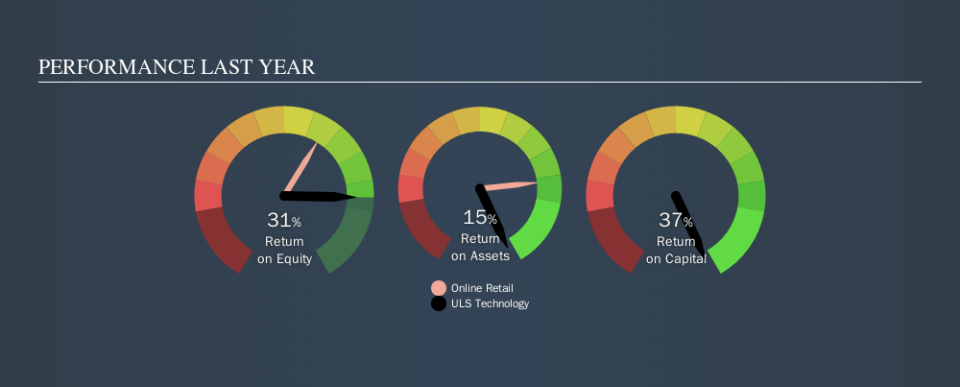Is ULS Technology plc’s (LON:ULS) 37% ROCE Any Good?

Today we are going to look at ULS Technology plc (LON:ULS) to see whether it might be an attractive investment prospect. To be precise, we'll consider its Return On Capital Employed (ROCE), as that will inform our view of the quality of the business.
First of all, we'll work out how to calculate ROCE. Next, we'll compare it to others in its industry. Then we'll determine how its current liabilities are affecting its ROCE.
Return On Capital Employed (ROCE): What is it?
ROCE measures the 'return' (pre-tax profit) a company generates from capital employed in its business. Generally speaking a higher ROCE is better. In brief, it is a useful tool, but it is not without drawbacks. Author Edwin Whiting says to be careful when comparing the ROCE of different businesses, since 'No two businesses are exactly alike.
So, How Do We Calculate ROCE?
Analysts use this formula to calculate return on capital employed:
Return on Capital Employed = Earnings Before Interest and Tax (EBIT) ÷ (Total Assets - Current Liabilities)
Or for ULS Technology:
0.37 = UK£5.0m ÷ (UK£23m - UK£9.1m) (Based on the trailing twelve months to March 2019.)
So, ULS Technology has an ROCE of 37%.
See our latest analysis for ULS Technology
Does ULS Technology Have A Good ROCE?
One way to assess ROCE is to compare similar companies. In our analysis, ULS Technology's ROCE is meaningfully higher than the 19% average in the Online Retail industry. We consider this a positive sign, because it suggests it uses capital more efficiently than similar companies. Putting aside its position relative to its industry for now, in absolute terms, ULS Technology's ROCE is currently very good.
You can click on the image below to see (in greater detail) how ULS Technology's past growth compares to other companies.
It is important to remember that ROCE shows past performance, and is not necessarily predictive. ROCE can be deceptive for cyclical businesses, as returns can look incredible in boom times, and terribly low in downturns. This is because ROCE only looks at one year, instead of considering returns across a whole cycle. Since the future is so important for investors, you should check out our free report on analyst forecasts for ULS Technology.
ULS Technology's Current Liabilities And Their Impact On Its ROCE
Liabilities, such as supplier bills and bank overdrafts, are referred to as current liabilities if they need to be paid within 12 months. Due to the way the ROCE equation works, having large bills due in the near term can make it look as though a company has less capital employed, and thus a higher ROCE than usual. To check the impact of this, we calculate if a company has high current liabilities relative to its total assets.
ULS Technology has total liabilities of UK£9.1m and total assets of UK£23m. As a result, its current liabilities are equal to approximately 40% of its total assets. A medium level of current liabilities boosts ULS Technology's ROCE somewhat.
Our Take On ULS Technology's ROCE
Still, it has a high ROCE, and may be an interesting prospect for further research. ULS Technology shapes up well under this analysis, but it is far from the only business delivering excellent numbers . You might also want to check this free collection of companies delivering excellent earnings growth.
I will like ULS Technology better if I see some big insider buys. While we wait, check out this free list of growing companies with considerable, recent, insider buying.
We aim to bring you long-term focused research analysis driven by fundamental data. Note that our analysis may not factor in the latest price-sensitive company announcements or qualitative material.
If you spot an error that warrants correction, please contact the editor at editorial-team@simplywallst.com. This article by Simply Wall St is general in nature. It does not constitute a recommendation to buy or sell any stock, and does not take account of your objectives, or your financial situation. Simply Wall St has no position in the stocks mentioned. Thank you for reading.


